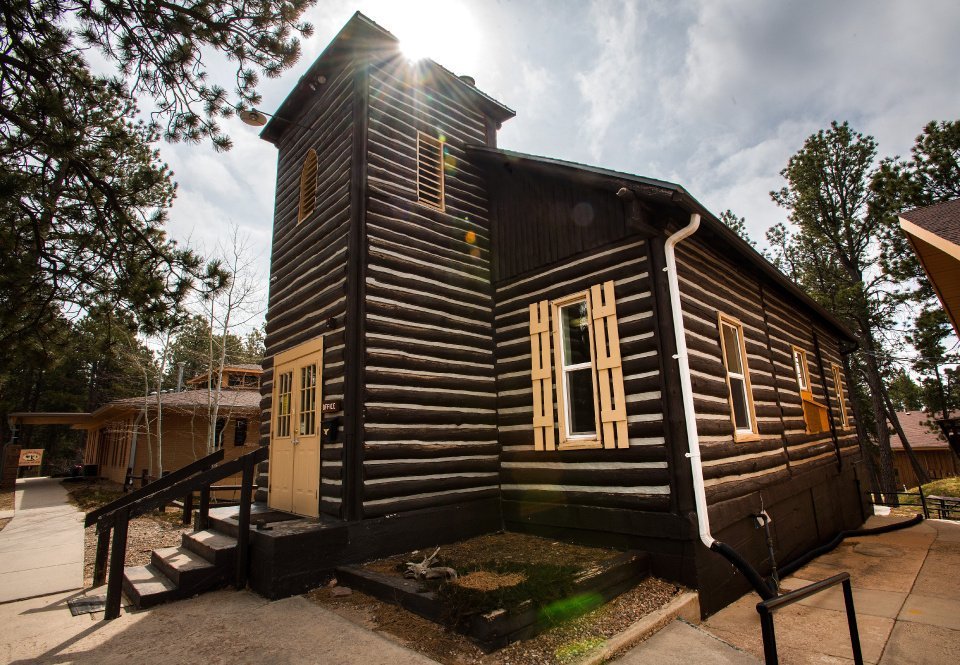Deep Roots in Black Forest
“Forty-five years ago a Sunday school meeting was held in a log school house on the northwest corner of Shoup and Black Forest Roads. The latter road was then known as Templeton Gap.
With no professional leadership available, the few residents in 1932 invested their time and energy in creating a spiritual foundation for their children, themselves, and the future of the community.
Today the results of this investment can be seen in the buildings on the southeast corner, the site of the present Black Forest Community Church. In the 1930s, individuals working with talents at hand had music and fellowship that provided the basis for vespers. Occasionally a visiting clergyman would preach on the Word.
A group of women, in 1936, organized a Ladies Aid for the purpose of assisting the spiritual life of the community and to take seriously the job of raising money for the construction of a church building. Quilting bees and ice cream socials netted profits from $1.50 to perhaps $10.
As more clergymen heard of the ladies’ cooking, they headed out from Colorado Springs. According to old timers, money did not seem to be their motive. They only received what the morning offering provided, often a few coins or sometimes a dollar bill.
The Black Forest Community Church became incorporated in 1937, on two acres of donated land. Labor was also donated. Two years later the foundation was completed during the winter. The little log school housed approximately 35 people who gathered for services. Progress was slow, and funds limited. In 1940 the shell was sufficiently finished for use. Formal dedication was made in 1942.
During this period the first pastor, Joseph McKittrick, a retired Presbyterian, was obtained. Dedicated spirit substituted for the lack of architectural “pizzaz” and it became a cathedral of love, a monument of concern and faith in the midst of a pioneer community.
Gas lanterns were replaced by electricity in 1946 and the heat, furnished by the coal stove, was obtained by the use of natural gas furnaces in 1961.
The role in shaping the destiny of the Community Church was enhanced in the 1940’s when La Foret (the Bemis Taylor estate) on Shoup Road was the Conference Center for the Colorado Conference of Congregational Churches.
The Black Forest Community Church (BFCC) members needed a sense of belongingness. After investigation the Congregational Church answered their need. A non-creedal Christian group, the latter appreciated the width and breadth of Christian understanding, without a test of faith for membership. Several La Foret camp managers became part-time ministers to the BFCC, then known as the Congregational Community Church.
The changes that occurred after the Air Force Academy was located here were due to economic and geographic factors affecting the area. The changes in the 1960’s put a burden on the log church. A full-time minister was hired and the church went off the mission status. It was now self-supporting.
The decision to build a new sanctuary, instead of adding to the log church, was made. A congregational meeting, in April of 1962, decided for a new sanctuary. The ground was broken in August and the first worship was held on Christmas Sunday. The log church was totally renovated in the early seventies and will be kept as a part of the BFCC complex and also as a landmark belonging to the Black Forest community.
The BFCC is proud of its charter which placed no infringement upon the personal beliefs of its individual members while remaining true to the mainstream of Protestant Christian thought. It has also taken seriously to the idea that the church is a member of the community and has responsibility to it.
The church has held, still does, and will continue to hold an open door policy with community groups welcome to use the church. Scouting, community library, well-baby clinic, Sheriff’s Posse, civic clubs and others have taken advantage of this policy.
When the Catholics first came to the area, they found shelter for their services in the log church. Protestant services were being held in the new sanctuary and Catholic Mass was being celebrated in the log church. Presently the Lutheran Church shares the Community Church facility and, on any given Sunday, the Christian Scientists are worshipping in the log church.
The church parsonage was built on five acres of donated land in the 1960’s and the mortgage was burned in the 1970’s. Moving forward, the congregation searches for new and greater ways to witness and serve the Lord and our community.”
From an article by Gene Manfrin, published in the Black Forest News (1977)
DID YOU KNOW….By Bessie Radspinner
The seat cushions on the pews were made and gifted to the church by two women members who were retired schoolteachers that started an upholstery business.
Gene Manfrin recruited an AF Academy engineering class to build the wheelchair ramp for the church.
Edith Wolford set the style for women to wear pants one frigid Sunday morning when she came to church in a wool pantsuit.
Dalton Murrah who checked the big candles every week to make sure they had enough wick to light, built a footstool for his wife so she could be comfortable sitting in the pew.
The beautiful candle holders on the altar were carved by Jack Faubel, a builder of homes (the House that Jack Built). He never attended church, but wanted to do something special for BFCC.
Ruth Elson, a very tall lady, used to sit way in the back because she liked to wear really big hats.
The entry door carvings of the apostles Matthew and Mark, were created by Katy White on black walnut wood from Virginia.
The African Folk Art drawing in the fellowship hall was done by Koffi Mbairamadji, an immigrant from Chad.




